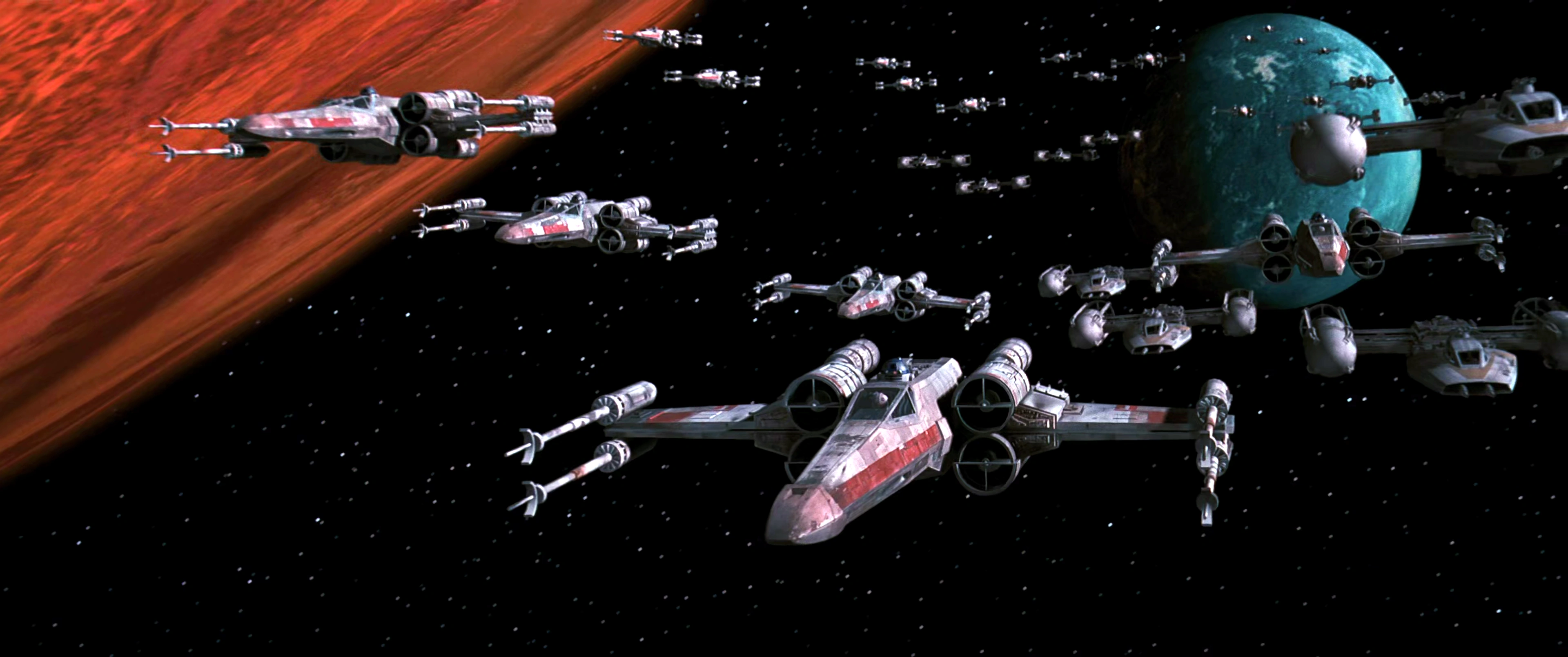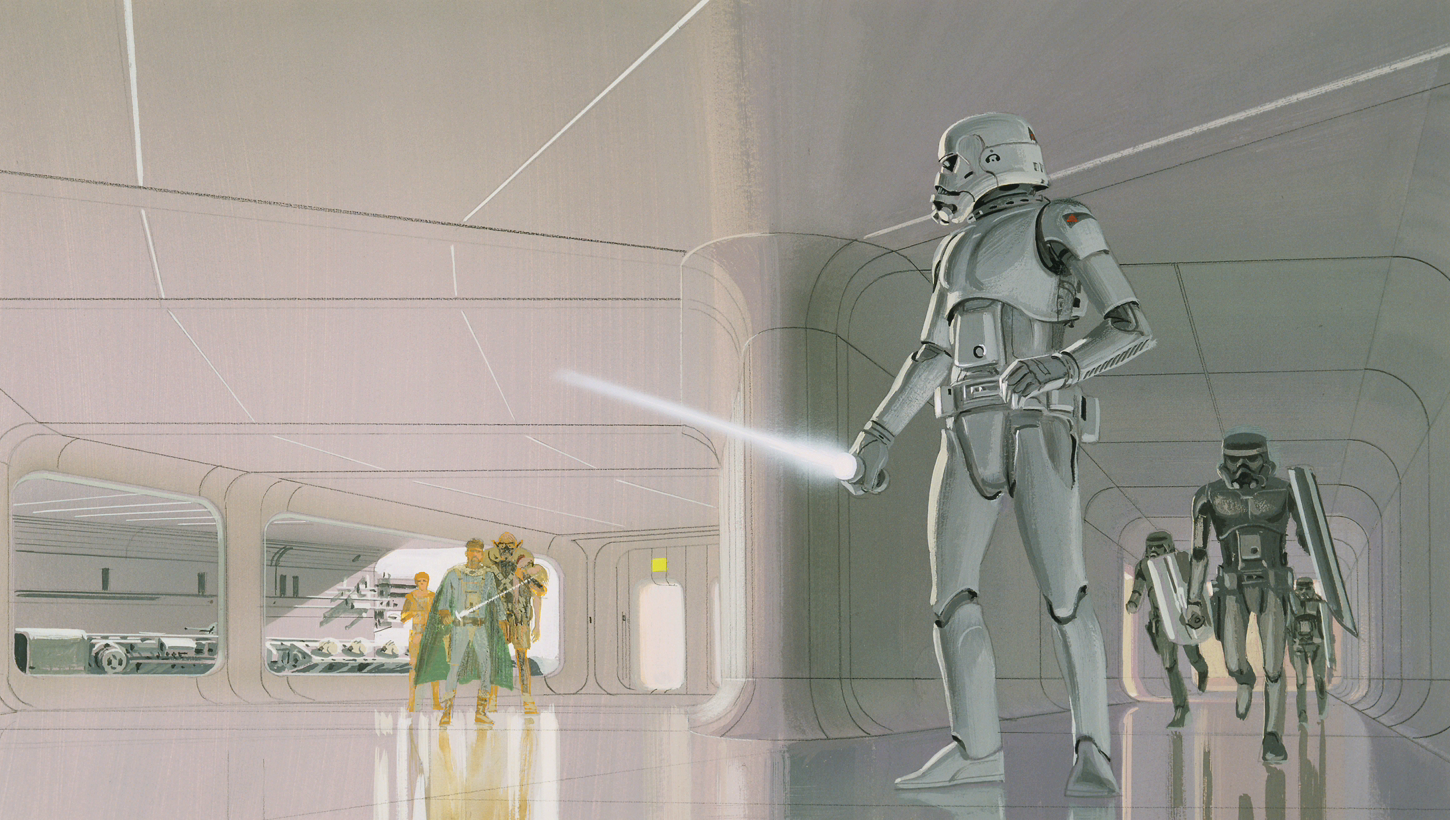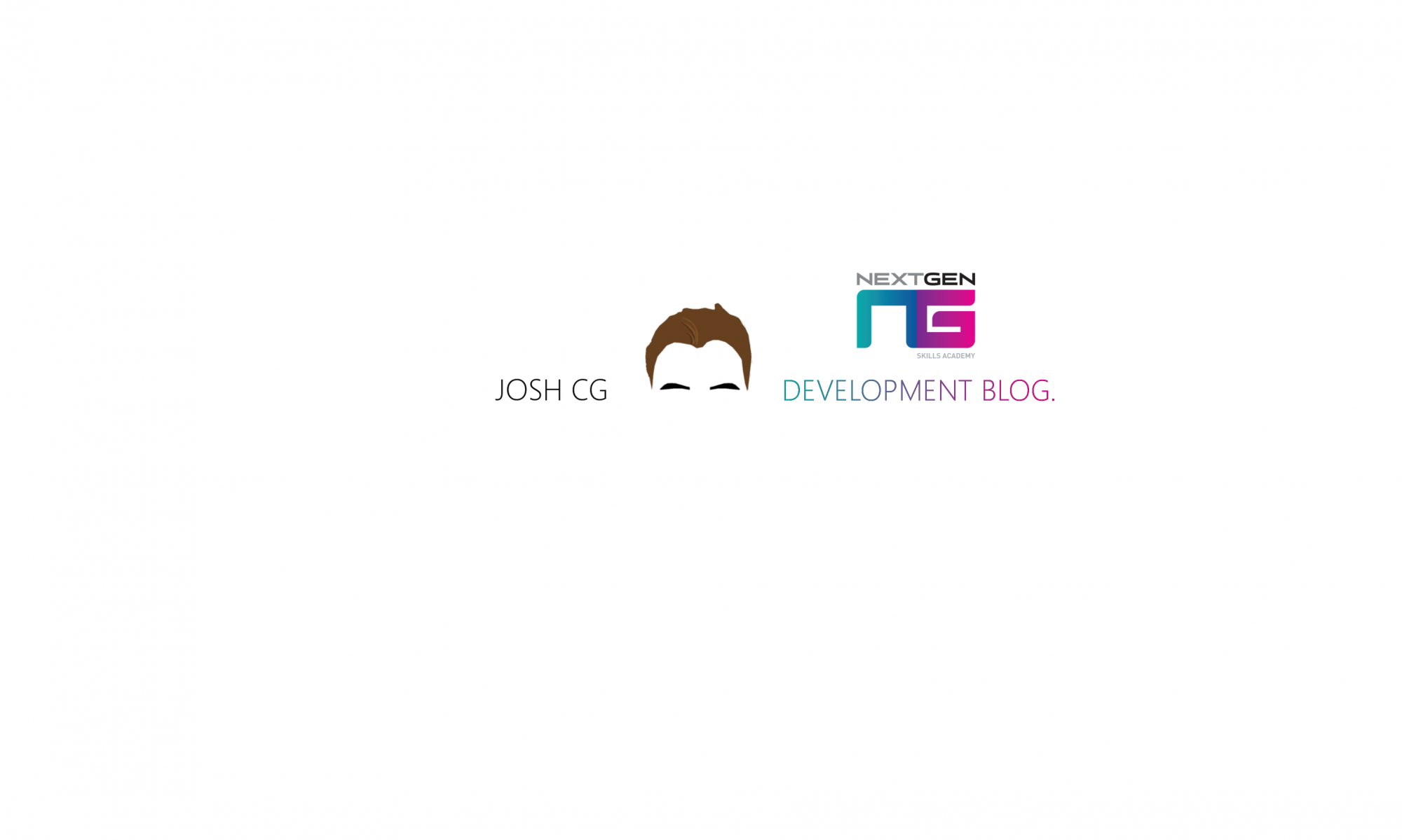I think it’s safe to say that art is definitely a key part of creating any IP, whether it’s a game or even a movie. To fully visualise anything in pre-production really helps in the long run, therefore shaping the overall look of the final product. Thanks to his inspiration conceptual pieces, Ralph McQuarrie helped to shape the overall look of the Star Wars Saga and the Star Wars Universe; the result of those pieces being the lush environments of alien planets such as Tattooine and Endor and even iconic characters such as Darth Vader, Chewbacca; even C-3PO and R2D2. So you’re probably wondering, who is Ralph McQuarrie? Ralph McQuarrie was an American concept artist, designer and illustrator. His most notable artistic contribution being for the original Star Wars trilogy, however McQuarrie also created pieces for E.T – The Extra Terrestrial and Cocoon. However in this post I’ll just be covering his work on the original Star Wars Trilogy.
So you’re probably wondering, who is Ralph McQuarrie? Ralph McQuarrie was an American concept artist, designer and illustrator. His most notable artistic contribution being for the original Star Wars trilogy, however McQuarrie also created pieces for E.T – The Extra Terrestrial and Cocoon. However in this post I’ll just be covering his work on the original Star Wars Trilogy. One thing that many people don’t know about Ralph McQuarrie is that he started off in a dentistry firm drawing both teeth and equipment. Soon after his job at the dentistry firm, McQuarrie went on to work as a Preliminary Design Illustrator for the Boeing Company. Here he drew diagrams for manuals on constructing the 747 Jumbo Jet.
One thing that many people don’t know about Ralph McQuarrie is that he started off in a dentistry firm drawing both teeth and equipment. Soon after his job at the dentistry firm, McQuarrie went on to work as a Preliminary Design Illustrator for the Boeing Company. Here he drew diagrams for manuals on constructing the 747 Jumbo Jet.
It wasn’t until 1975 when director and filmmaker George Lucas, was mesmerised with his work and met up with McQuarrie to talk about Lucas’ plans for a ‘space-fantasy film’; it was then when Lucas commissioned McQuarrie to illustrate scenes from the film based on the script.

Not only is McQuarrie responsible for the look of iconic characters such s C-3PO, Darth Vader and Chewbacca, but he is also responsible for the iconic looks of such planets and locations like Tatooine, the Mos Eisley cantina, the Death Star and even Yavin 4. Ralphs work was so important and valued by the franchise that George Lucas made sure that the shots in the movie replicated his paintings exactly. This is why his Star Wars portfolio is so vital to the overall aesthetic of the original trilogy. There are also many examples of where some of Ralph McQuarries art work has been re-used to aid other parts of the Star Universe, outside of the original trilogy. One of many noticeable examples of this is the design of Zeb Orrelios from the Star Wars Rebels animated TV series. With this side by side comparison, you can clearly see that Zeb’s character design is heavily based off of the original concepts of everyone’s favourite walking carpet, Chewbacca.
Ralphs work was so important and valued by the franchise that George Lucas made sure that the shots in the movie replicated his paintings exactly. This is why his Star Wars portfolio is so vital to the overall aesthetic of the original trilogy. There are also many examples of where some of Ralph McQuarries art work has been re-used to aid other parts of the Star Universe, outside of the original trilogy. One of many noticeable examples of this is the design of Zeb Orrelios from the Star Wars Rebels animated TV series. With this side by side comparison, you can clearly see that Zeb’s character design is heavily based off of the original concepts of everyone’s favourite walking carpet, Chewbacca.

Even the Storm trooper training gear seen very early on in the Rebels TV series looks similar in design compared to McQuarries earlier Storm trooper concepts.


As well as this there are other examples of McQuarries influence later on in the saga: twice! These examples are present in 2015’s Star Wars: The Force Awakens. The first being the architecture in Rey’s Village on Jakku. The visual style looks almost identical to McQuarries original concept piece of the outside of Jabba’s Palace in the original trilogy.


Another example is the design of the X-Wings in this film. As you can see the Design is completely different to the original X-Wings in Episodes 4, 5 and 6.


The new design looks like the original concepts done by Ralph McQuarrie of this X-Wing dog fighting in space with this TIE Fighter. The similarities between this X-Wing and the X-Wing class from the Force Awakens being that they both share the same engine design: this being semi-circular. But if I’m honest one of my favourite pieces done by Ralph has got to be the piece which appears to be set on Cloud City, where we see lightsabre wielding Storm troopers for the first time; maybe this could’ve been inspiration for the Storm trooper TR-8R in the Force Awakens, who knows.
But if I’m honest one of my favourite pieces done by Ralph has got to be the piece which appears to be set on Cloud City, where we see lightsabre wielding Storm troopers for the first time; maybe this could’ve been inspiration for the Storm trooper TR-8R in the Force Awakens, who knows.
 Every artist has their inspiration no matter if it’s a specific movement or artist; Ralph McQuarrie is no exception. From all of the production paintings McQuarrie produced, it was the concept of R2-D2 and C-3PO wandering the desert that was completed first.
Every artist has their inspiration no matter if it’s a specific movement or artist; Ralph McQuarrie is no exception. From all of the production paintings McQuarrie produced, it was the concept of R2-D2 and C-3PO wandering the desert that was completed first. If you analyse the painting very closely, it’s quite apparent that Art Deco movement may have heavily inspired McQuarries piece. What do I mean by this? Well if you compare C-3P0 to the Art Deco robot, Mashinenmensch from Fritz Lang’s film from 1927, Metropolis, then you’ll notice that the resemblance is uncanny.
If you analyse the painting very closely, it’s quite apparent that Art Deco movement may have heavily inspired McQuarries piece. What do I mean by this? Well if you compare C-3P0 to the Art Deco robot, Mashinenmensch from Fritz Lang’s film from 1927, Metropolis, then you’ll notice that the resemblance is uncanny. Not only did this painting start the design of C-3PO off, but it also had an impact on the actor who would later play him, Anthony Daniels.
Not only did this painting start the design of C-3PO off, but it also had an impact on the actor who would later play him, Anthony Daniels. Daniels even said himself that the figure of McQuarries design had ‘a rather wistful’, ‘yearning’ and ‘rather bereft quality’ which Daniels ‘found very appealing’. Thanks to McQuarries painting, Daniels accepted the role as C-3PO.
Daniels even said himself that the figure of McQuarries design had ‘a rather wistful’, ‘yearning’ and ‘rather bereft quality’ which Daniels ‘found very appealing’. Thanks to McQuarries painting, Daniels accepted the role as C-3PO.
Soon after the first film, McQuarrie went on to create other pre-visualisation concept art for the following films: Empire Strikes Back and The Return of The Jedi. Despite not working on the prequel trilogy and experiencing creative fatigue, it’s safe to say that Ralph McQuarries work has definitely inspired the Star Wars Universe as a whole. He may not still be around today but thanks to his influence, he has truly left his mark on the world of cinema with his work on Star Wars.
Despite not working on the prequel trilogy and experiencing creative fatigue, it’s safe to say that Ralph McQuarries work has definitely inspired the Star Wars Universe as a whole. He may not still be around today but thanks to his influence, he has truly left his mark on the world of cinema with his work on Star Wars.



 So with this in mind I created an entire concept piece from scratch in Photoshop, trying to illustrate how I thought the scene should look. The piece took me roughly 5-6 hours to really get right. It may not be the best piece produced for the project but its noticeably one of my best pieces that I’ve produced all year. Here’s part of a time-lapse of me drawing the piece and below that the final piece itself…
So with this in mind I created an entire concept piece from scratch in Photoshop, trying to illustrate how I thought the scene should look. The piece took me roughly 5-6 hours to really get right. It may not be the best piece produced for the project but its noticeably one of my best pieces that I’ve produced all year. Here’s part of a time-lapse of me drawing the piece and below that the final piece itself… Overall I’m very happy with how this piece turned out and I think that it’s definitely improved my digital art skills.
Overall I’m very happy with how this piece turned out and I think that it’s definitely improved my digital art skills.


 But we did in fact encounter some issues. These were mainly issues in post. For example some scenes looked incredibly grainy due to the lighting being low and the ISO on the camera being cranked up as a result, therefore causing the grainy look; we even encountered some issues where some shots were the polar opposite and were over exposed, sometimes causing light to over power the subject or camera in terms of lighting. Another issue was that there was too much motion blur in some pieces of footage, this was an issue for tracking mainly as sometimes the tracker would be thrown off position in After Effects whilst tracking an object or person. This was due to the shutter speed being slow which as a result created more motion blur when the subject or camera was moving.
But we did in fact encounter some issues. These were mainly issues in post. For example some scenes looked incredibly grainy due to the lighting being low and the ISO on the camera being cranked up as a result, therefore causing the grainy look; we even encountered some issues where some shots were the polar opposite and were over exposed, sometimes causing light to over power the subject or camera in terms of lighting. Another issue was that there was too much motion blur in some pieces of footage, this was an issue for tracking mainly as sometimes the tracker would be thrown off position in After Effects whilst tracking an object or person. This was due to the shutter speed being slow which as a result created more motion blur when the subject or camera was moving. Reflecting back on the filming dates, I think that there is definitely room for improvement if we were to do a project like this again. For instance, I’d make sure that the shot supervisor was fully aware of what they were doing before starting and were fully educated on the basics of cameras, ISO and shutter speed, therefore giving shots a more polished look and making thinks easier to track in post. I would also make sure that we had the right equipment. What i mean by this is perhaps a microphone for better audio quality and different types of tape for markers so that the actors knew where they were going to be in the next scene and so on.
Reflecting back on the filming dates, I think that there is definitely room for improvement if we were to do a project like this again. For instance, I’d make sure that the shot supervisor was fully aware of what they were doing before starting and were fully educated on the basics of cameras, ISO and shutter speed, therefore giving shots a more polished look and making thinks easier to track in post. I would also make sure that we had the right equipment. What i mean by this is perhaps a microphone for better audio quality and different types of tape for markers so that the actors knew where they were going to be in the next scene and so on.
 Well in our first meeting, we were shocked to discover that out of the many actors that put their name down to take part, only 3 of them turned up. Meeting after meeting, week after week, the less the actors turned up; at one point no one turned up at all. This was unacceptable and wouldn’t be tolerated in the industry and with that being said, this had to be our mindset during this time. So with this we got rid of the actors, since all we really got from them was test footage.
Well in our first meeting, we were shocked to discover that out of the many actors that put their name down to take part, only 3 of them turned up. Meeting after meeting, week after week, the less the actors turned up; at one point no one turned up at all. This was unacceptable and wouldn’t be tolerated in the industry and with that being said, this had to be our mindset during this time. So with this we got rid of the actors, since all we really got from them was test footage.